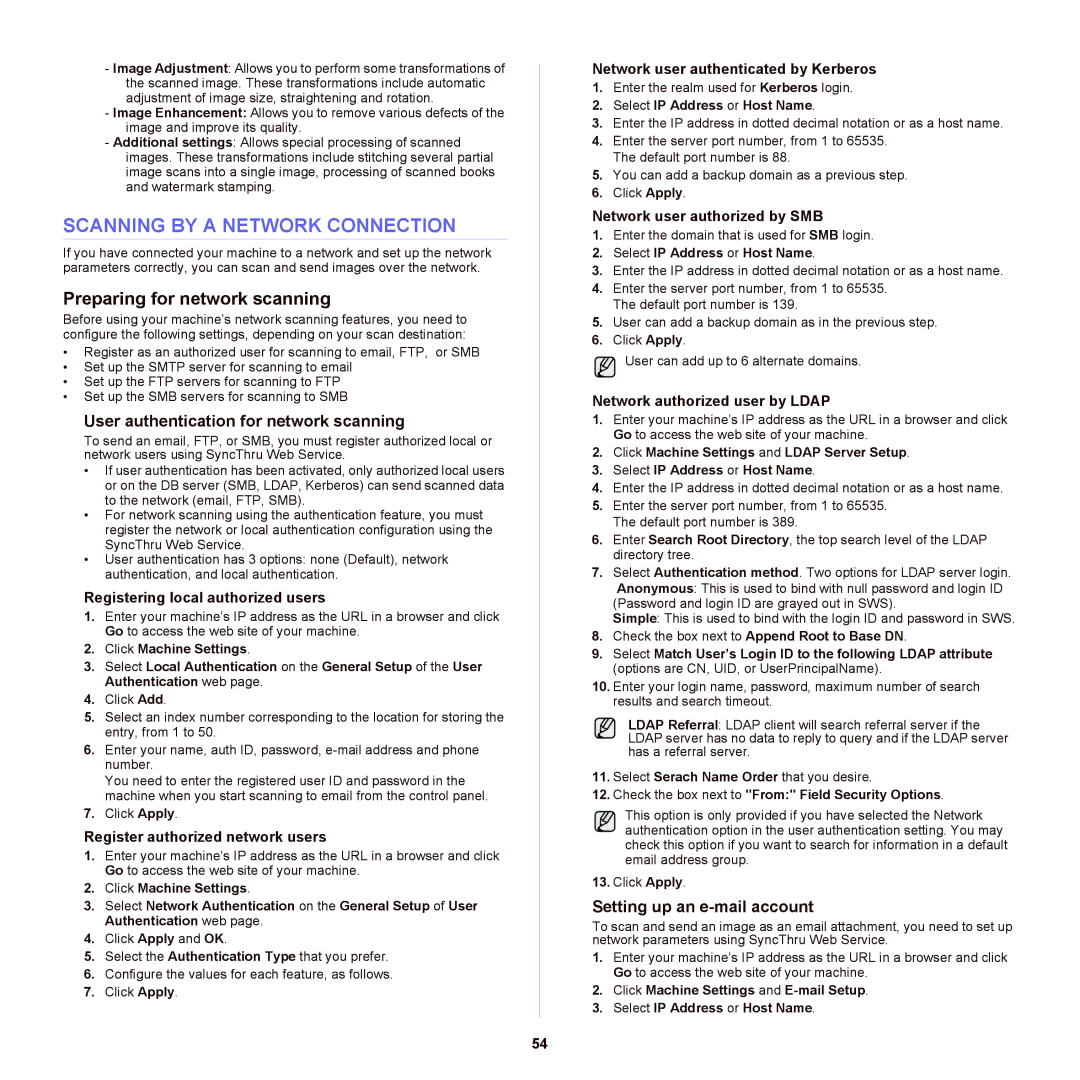
-Image Adjustment: Allows you to perform some transformations of the scanned image. These transformations include automatic adjustment of image size, straightening and rotation.
-Image Enhancement: Allows you to remove various defects of the image and improve its quality.
-Additional settings: Allows special processing of scanned images. These transformations include stitching several partial image scans into a single image, processing of scanned books and watermark stamping.
SCANNING BY A NETWORK CONNECTION
If you have connected your machine to a network and set up the network parameters correctly, you can scan and send images over the network.
Preparing for network scanning
Before using your machine’s network scanning features, you need to configure the following settings, depending on your scan destination:
•Register as an authorized user for scanning to email, FTP, or SMB
•Set up the SMTP server for scanning to email
•Set up the FTP servers for scanning to FTP
•Set up the SMB servers for scanning to SMB
User authentication for network scanning
To send an email, FTP, or SMB, you must register authorized local or network users using SyncThru Web Service.
•If user authentication has been activated, only authorized local users or on the DB server (SMB, LDAP, Kerberos) can send scanned data to the network (email, FTP, SMB).
•For network scanning using the authentication feature, you must register the network or local authentication configuration using the SyncThru Web Service.
•User authentication has 3 options: none (Default), network authentication, and local authentication.
Registering local authorized users
1.Enter your machine’s IP address as the URL in a browser and click Go to access the web site of your machine.
2.Click Machine Settings.
3.Select Local Authentication on the General Setup of the User Authentication web page.
4.Click Add.
5.Select an index number corresponding to the location for storing the entry, from 1 to 50.
6.Enter your name, auth ID, password,
You need to enter the registered user ID and password in the machine when you start scanning to email from the control panel.
7.Click Apply.
Register authorized network users
1.Enter your machine’s IP address as the URL in a browser and click Go to access the web site of your machine.
2.Click Machine Settings.
3.Select Network Authentication on the General Setup of User Authentication web page.
4.Click Apply and OK.
5.Select the Authentication Type that you prefer.
6.Configure the values for each feature, as follows.
7.Click Apply.
Network user authenticated by Kerberos
1.Enter the realm used for Kerberos login.
2.Select IP Address or Host Name.
3.Enter the IP address in dotted decimal notation or as a host name.
4.Enter the server port number, from 1 to 65535. The default port number is 88.
5.You can add a backup domain as a previous step.
6.Click Apply.
Network user authorized by SMB
1.Enter the domain that is used for SMB login.
2.Select IP Address or Host Name.
3.Enter the IP address in dotted decimal notation or as a host name.
4.Enter the server port number, from 1 to 65535. The default port number is 139.
5.User can add a backup domain as in the previous step.
6.Click Apply.
User can add up to 6 alternate domains.
Network authorized user by LDAP
1.Enter your machine’s IP address as the URL in a browser and click Go to access the web site of your machine.
2.Click Machine Settings and LDAP Server Setup.
3.Select IP Address or Host Name.
4.Enter the IP address in dotted decimal notation or as a host name.
5.Enter the server port number, from 1 to 65535. The default port number is 389.
6.Enter Search Root Directory, the top search level of the LDAP directory tree.
7.Select Authentication method. Two options for LDAP server login.
Anonymous: This is used to bind with null password and login ID (Password and login ID are grayed out in SWS).
Simple: This is used to bind with the login ID and password in SWS.
8.Check the box next to Append Root to Base DN.
9.Select Match User’s Login ID to the following LDAP attribute (options are CN, UID, or UserPrincipalName).
10.Enter your login name, password, maximum number of search results and search timeout.
LDAP Referral: LDAP client will search referral server if the LDAP server has no data to reply to query and if the LDAP server has a referral server.
11.Select Serach Name Order that you desire.
12.Check the box next to "From:" Field Security Options.
This option is only provided if you have selected the Network authentication option in the user authentication setting. You may check this option if you want to search for information in a default email address group.
13.Click Apply.
Setting up an e-mail account
To scan and send an image as an email attachment, you need to set up network parameters using SyncThru Web Service.
1.Enter your machine’s IP address as the URL in a browser and click Go to access the web site of your machine.
2.Click Machine Settings and
3.Select IP Address or Host Name.
54
